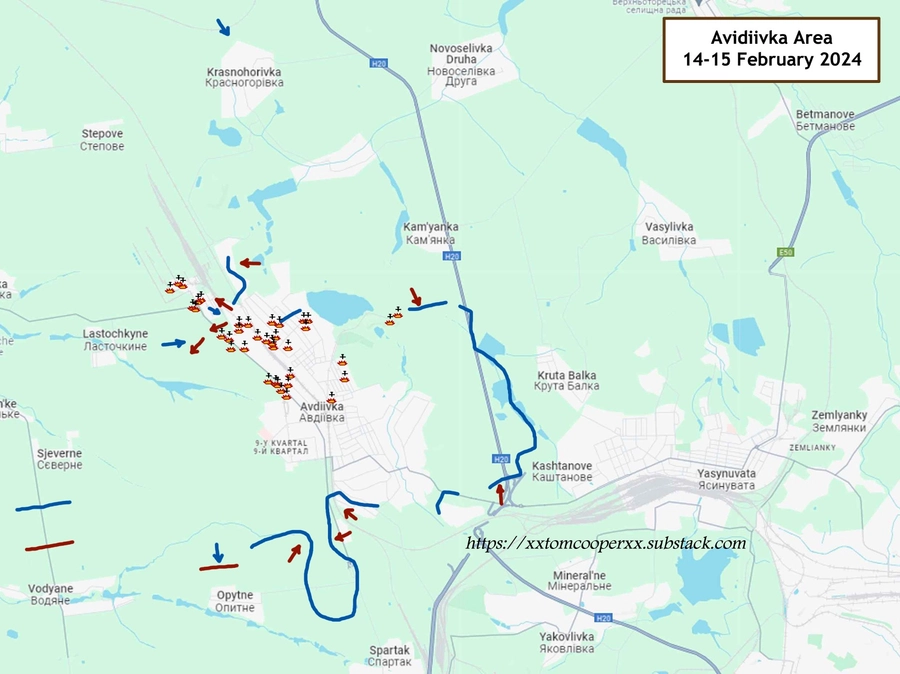The Russian Air Force is hitting ground targets at an - for it - unprecedented pace and most likely the Kremlin’s airmen just blew the war’s one-day air strike record to bits.
On Feb. 14 Russian aircraft of all types released 159 individual air-released rockets, dumb or glide bombs, or air-to-ground missiles at Ukrainian military targets, homes or businesses, official counts by made public on Thursday by the Armed Forces of Ukraine (AFU) said.
JOIN US ON TELEGRAM
Follow our coverage of the war on the @Kyivpost_official.
That weight of sky-delivered explosives and the sortie rate by Russian military airmen and ground crews sustaining it has, in the past 18 months, been only approached twice before in the entire war: 127 Russian weapons dropped or fired on Jan. 1, 2024, and 128 munitions of various types on Jan 18, a recent review by open-source data researcher Ragnar Gudmundsson found.
The Russian Air Force appears to be on pace to break the one-month air strike record as well. The previous high mark, in January 2024, counted 1,888 drops of all weapon types. Recent Russian air operations - 1,206 in the first two weeks of Feb. 2024 alone - are clear evidence of steadily intensifying Kremlin air attacks, and a Ukrainian military seemingly unable to slow never mind stop the trend, data published by Gudmundsson on Thursday showed.
According to Ukrainian soldiers and military information platforms, and their Russian counterparts, the most intense air pounding has been against AFU positions around the Donbas city Avdiivka, where Ukrainian forces from 47th Mechanized and 3rd Assault Brigades are defending an almost-surrounded enclave cutting deep into Russian lines.

‘Realistic Plan’ to Retake Crimea, Battlefield Assessments – Key Points from Syrsky’s Guardian Interview
Ukrainian volunteer Alexander Kovalenko in a Feb. 13 analysis published on his personal Telegram channel said the Russian air force increasingly was using glider bombs rigged with flip-out wings and movable control surfaces, enabling Russian pilots to let loose munitions from as far as 70 km. away from Avdiivka, well outside the range of frontline Ukrainian air defenses.
At the outset of Russia’s second invasion of Ukraine, in February 2022, almost all bombs dropped by the Russian Air Force were “dumb” bombs relying on inertia and pilot aiming skill to hit a target.
During the first third of February 2024 about every second bomb dropped by the Russian air force, in Ukraine, has been equipped with a range extension kit, and recently about 40 weapons have been hitting in and around Avdiivka daily, Kovalenko said.
The pro-Russia military information platform Voenniy Osvedomitel’ claimed that the one-day record currently is 50 glider bombs.
Jan. 5 official Kremlin image of a Russian FAB-500M62 bomb fitted with a UMPK glide kit.
According to 2023 research by the US Popular Mechanics magazine entitled “How Dumb are Russia’s Smart Bombs?” it’s not clear whether Russian bombs range-extension kits contain GPS guidance electronics or not, but with munition weights ranging from 250 kg. to 1.5 metric tons, precise accuracy very likely is not a high priority with Russian air force planners trained for generations to saturate a target area with high explosives.
Three other focuses of ongoing Russian ground assaults and intense ground combat, around the north-eastern town Kupyansk, the eastern city Bakhmut, and the Zaporizhzhia village of Robotyne, also have seen dense use of Russian glider bombs against AFU troops and possible facilities in recent weeks, Ukrainian official and informal military information sources said.
Austrian military aviation analyst Tom Cooper in a Feb. 13 report said: ”Su-34s are deploying up to four bombs per sortie, not just two – like most of the last year (2023)… Primary target(s) remain high-rise buildings used by Ukrainians for observation purposes, plus to deploy anti-tank guided missiles and snipers.”
Video of an early February Russian glide bomb air strike against Avdiivka’s residential 9th district, and published by the independent Noelreports information platform, showed two bombs detonating among hi-rise apartment buildings. Most structures had already been badly damaged by previous air or artillery strikes, images showed.
This is how Russia is operating in Avdiivka. Dropping glide bombs over and over, destroying cities, razing it to the ground before trying to enter. A common Russian strategy.
— NOELREPORTS 🇪🇺 🇺🇦 (@NOELreports) February 13, 2024
In this video the 9th quarter of Avdiivka is being bombed heavily. pic.twitter.com/YjCj3O6DUp
On the southwest end of the 1,600 km-long fighting front, near the Dnipro River city Kherson, the skies of a small Ukrainian Marine bridgehead in recent weeks have been an outlier and relatively free from Russian air strikes.
Map graphic of probable locations of Russian air strikes in the Avdiivka sector, Feb. 14-15, by Tom Cooper and Andrew Pereputa.
According to both AFU Marine and pro-Russia information platforms, for most of February, the only Russian air attacks against Ukraine Marine positions near the left-bank village of Krynky have been inaccurate, hit-and-run rocket raids by helicopter gunships, while Russian bombers are simply avoiding the area.
Official Russian sources have said operations against the Ukrainian bridgehead are proceeding normally, that Ukrainian cross-river positions (established in October) are weak and that they will be crushed in due course.
Independent observers suggest the absence of Russian air force jets for attacks against the Krynky bridgehead and defenses around it, is probably linked to a series of late December southern front shootdowns, knocking four Russian Su-34 attack jets and a single Su-30 fighter out skies in a little more than 72 hours.
Unconfirmed reports suggested Kyiv had secretly deployed a US-made Patriot long-range air defense system to someplace near Kherson, and Russian bomber pilots thinking the range of their glider bombs would keep them out of harm’s way flew into a series of air ambushes.
Feb. 12 comments by an unnamed Russian paratrooper call sign “Tsyrkach,” purportedly an officer serving in 2nd Company, 337th Regiment, 104th Airborne Assault Division said the Russian Air Force still was not flying in his sector and that Russian airmen had attempted no air strikes against Marine positions around the bridgehead, in weeks.
On the Ukrainian side of the lines, in sectors most heavily pounded by Russian bombs, complaints continued about the difficulty of having to fight off Kremlin ground attacks while the Russian Air Force can hit AFU troops without fear of retaliation.
“If you wonder why Ukrainian defenses in Avdiivka aren’t holding up. They need long-range air defense. Preferably (jet) fighters with long-range air-to-air missiles. Like, for example, a Meteor (European active radar guided beyond-visual-range air-to-air) missile,” wrote Andrew Perpetua, a leading organizer of volunteer support to front-line troops, in a Feb. 15 “X” comment.
Ukrainian Air Force spokespersons earlier this week said the AFU should start operating Netherlands- and Denmark-donated F-16 fighter jets to defend national air space “sometime in the Spring.”
According to Kremlin-sponsored news talk shows, Russian capacity to hit Ukrainian ground forces from the air with relative impunity, thanks to expected modernization and mass production of glider bombs, will last at least until Summer, and possibly for months after that.
You can also highlight the text and press Ctrl + Enter











